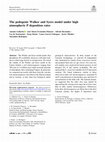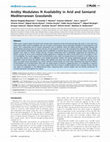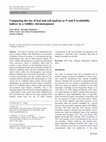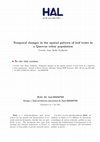Papers by Antonio Gallardo
Functional Ecology, 2020
This article has been accepted for publication and undergone full peer review but has not been th... more This article has been accepted for publication and undergone full peer review but has not been through the copyediting, typesetting, pagination and proofreading process, which may lead to differences between this version and the Version of Record. Please cite this article as

Biogeochemistry, 2020
The Walker and Syers model predict that phosphorus (P) availability decreases with time leading t... more The Walker and Syers model predict that phosphorus (P) availability decreases with time leading to a final stage known as retrogression. We tested the validity of the Walker and Syers model in the Canary Islands, a soil chronosequence ranging from 300 years to 11 million years under recurrent episodes of atmospheric dust-containing P inputs. In particular, we compared our results with those from the volcanic soil chronosequences described in the Hawaii Islands and in Arizona, as they share key biological and/or geological characteristics. In three islands of the Canarian Archipelago, we selected 18 independent sites dominated by mature Pinus canariensis forests and grouped them into six age classes. For each site, soil samples were analyzed for known proxies of soil nitrogen (N), P and cations availability. We also analyzed the P. canariensis needles for N, P and cation contents. We found tendencies similar to those observed in other soil chronosequences: maximum N and P concentrati...

The New phytologist, Sep 22, 2016
Parasitic plants are important drivers of community and ecosystem properties. In this study, we i... more Parasitic plants are important drivers of community and ecosystem properties. In this study, we identify different mechanisms by which mistletoe (Viscum album subsp. austriacum) can affect soil chemical and biological properties at different temporal stages of parasitism. We quantified the effect of parasitism on host growth and the number of frugivorous mutualists visiting the host canopy. Then we collected, identified, and weighed the organic matter input underneath tree canopies and analyzed its nutrient content. Simultaneously, we analyzed soil samples under tree canopies and examined the chemical properties, microbial abundance, and functional evenness of heterotrophic microbial communities. Mistletoe increased the amount, quality, and diversity of organic matter input beneath the host canopy, directly through its nutrient-rich litter and indirectly through a reduction in host litterfall and an increase in bird-derived debris. All these effects gave rise to enriched hotspots ab...
Annals of Forest Science, 2015
& Key message The long-term effect of forest fires in the regeneration of Pinus canariensis was s... more & Key message The long-term effect of forest fires in the regeneration of Pinus canariensis was studied. Forest fires had little long-term effects on seed production, seedling germination and seedling mortality. The characteristics of different forest stands across the island had influence in some of the regeneration parameters studied.

Global Ecology and Biogeography, 2014
Aim The global spread of woody plants into grasslands is predicted to increase over the coming ce... more Aim The global spread of woody plants into grasslands is predicted to increase over the coming century. While there is general agreement regarding the anthropogenic causes of this phenomenon, its ecological consequences are less certain. We analysed how woody vegetation of differing cover affects plant diversity (richness and evenness) and the surrogates of multiple ecosystem processes (multifunctionality) in global drylands, and how these change with aridity. Location Two hundred and twenty-four dryland sites from all continents except Antarctica, widely differing in their environmental conditions (from arid to drysubhumid sites) and relative woody cover (from 0 to 100%). Methods Using a standardized field survey, we measured the cover, richness and evenness of perennial vegetation. At each site, we measured 14 soil variables related to fertility and the build-up of nutrient pools. These variables are critical for maintaining ecosystem functioning in drylands. Results Species richness and ecosystem multifunctionality were strongly related to woody vegetation, with both variables peaking at a relative woody cover (RWC) of 41-60%. This relationship shifted with aridity. We observed linear positive effects of RWC in dry-subhumid sites. These positive trends shifted to humpshaped RWC-diversity and multifunctionality relationships under semi-arid environments. Finally, hump-shaped (richness, evenness) or linear negative (multifunctionality) effects of RWC were found under the most arid conditions. Main conclusions Plant diversity and multifunctionality peaked at intermediate levels of woody cover, although this relationship became increasingly positive in wetter environments. This comprehensive study accounts for multiple ecosystem attributes across a range of levels of woody cover and environmental conditions. Our results help us to reconcile contrasting views of woody encroachment found in the current literature and can be used to improve predictions of the likely effects of encroachment on biodiversity and ecosystem services.

Soil Biology and Biochemistry, 2015
Climate and litter quality have been identified as major drivers of litter decomposition, but our... more Climate and litter quality have been identified as major drivers of litter decomposition, but our knowledge of how soil characteristics (e.g. microbial community and chemical properties) determine carbon (C) and nitrogen (N) availability derived from the decomposition of litter of different qualities is still scarce. We conducted a microcosm experiment to evaluate how soils with contrasting microbial communities and soil properties (denoted Soils A and B hereafter, where Soil B has higher bacterial and fungal abundance, fungal:bacterial ratio, and organic C than Soil A) determine the availability of soil C (carbohydrates, proteins, amino acids and phenols) and N (dissolved organic and inorganic N, microbial biomass N and available N) during the decomposition of litter of contrasting quality (C:N ratios ranging from 20 to 102). We also evaluated the relative importance of soil characteristics and litter quality as drivers of C and N inputs to the soil during this process. Overall, higher soil C and N availability after litter decomposition was found in Soil B than in Soil A. Soil characteristics had a higher positive effect on soil C and N contents than litter quality during litter decomposition. We also found that changes in N availability and organic matter quality registered after litter decomposition, linked to different soil characteristics, were able to promote dissimilarities in the potential mineralization rates. In conclusion, our study provides evidence that soil characteristics (e.g. microbial communities and chemical properties) can be more important than litter quality in determining soil C and equally important for N availability during the decomposition of leaf litter.

Soil Biology and Biochemistry, 2013
ABSTRACT Ionic exchange membranes (IEMs) are a potential alternative to traditional soil extracti... more ABSTRACT Ionic exchange membranes (IEMs) are a potential alternative to traditional soil extraction and incubation methods for estimating soil inorganic N availability. However, there have been few comparisons of IEMs with more widely used N availability measurements. Here we found a strong relationship between soil inorganic N availability obtained using IEMs, and traditional soil inorganic N extractions and mineralization rates over a wide range of soil types. We also found lower variability in soil inorganic N availability obtained with IEMs than with traditional measurements. We conclude that IEMs are a reliable method to estimate inorganic N production in soils, and may become a useful alternative or complement to more destructive and time consuming traditional soil extraction and incubation methods for estimating soil inorganic N availability.

PLoS ONE, 2013
While much is known about the factors that control each component of the terrestrial nitrogen (N)... more While much is known about the factors that control each component of the terrestrial nitrogen (N) cycle, it is less clear how these factors affect total N availability, the sum of organic and inorganic forms potentially available to microorganisms and plants. This is particularly true for N-poor ecosystems such as drylands, which are highly sensitive to climate change and desertification processes that can lead to the loss of soil nutrients such as N. We evaluated how different climatic, abiotic, plant and nutrient related factors correlate with N availability in semiarid Stipa tenacissima grasslands along a broad aridity gradient from Spain to Tunisia. Aridity had the strongest relationship with N availability, suggesting the importance of abiotic controls on the N cycle in drylands. Aridity appeared to modulate the effects of pH, plant cover and organic C (OC) on N availability. Our results suggest that N transformation rates, which are largely driven by variations in soil moisture, are not the direct drivers of N availability in the studied grasslands. Rather, the strong relationship between aridity and N availability could be driven by indirect effects that operate over long time scales (decades to millennia), including both biotic (e.g. plant cover) and abiotic (e.g. soil OC and pH). If these factors are in fact more important than short-term effects of precipitation on N transformation rates, then we might expect to observe a lagged decrease in N availability in response to increasing aridity. Nevertheless, our results suggest that the increase in aridity predicted with ongoing climate change will reduce N availability in the Mediterranean basin, impacting plant nutrient uptake and net primary production in semiarid grasslands throughout this region.

Plant and Soil, 2013
Aims Human activities are causing imbalances in the nutrient cycles in natural ecosystems. Howeve... more Aims Human activities are causing imbalances in the nutrient cycles in natural ecosystems. However, we have limited knowledge of how these changes will affect the soil microbial functional diversity and the nitrogen (N) cycle in drylands, the biggest biome on Earth. Communities dominated by lichens, mosses and cyanobacteria (biocrusts) influence multiple processes from the N cycle such as N fixation and mineralization rates. We evaluated how biocrusts modulate the effects of different N, carbon (C) and phosphorus (P) additions on theN availability, the dominance of different available N forms and the microbial functional diversity in dryland soils. Methods Soil samples from bare ground (BG) and biocrust-dominated areas were gathered from the center of Spain and incubated during seven or 21 days under different combinations of N, C and P additions (N, C, P, N+C, N+P, P+C, and C+N+P). Results The relative dominance of dissolved organic N (DON) and the microbial functional diversity were higher in biocrust than in BG microsites when C or P were added. Changes in the C to N ratio, more than N availability, seem to modulate N transformation processes in the soils studied. In general, biocrusts increased the resilience to N impacts (N, C+N, N+P, C+N+P) of the total available N, ammonium, nitrate and DON when C was present. Conclusions Our results suggest that biocrusts may buffer the effects of changes in nutrient ratios on microbial functional diversity and DON dominance in dryland soils. Thus, these organisms may have an important role in increasing the resilience of the N cycle to imbalances in C, N and P derived from human activities.

Plant and Soil, 2009
The effect of wildfire on ecosystem function is gaining interest since climate change is expected... more The effect of wildfire on ecosystem function is gaining interest since climate change is expected to increase fire frequency and intensity in many forest systems. Fire alters the nutritional status of forest ecosystems, affecting ecosystem function and productivity, but further studies evaluating changes in leaf nutrient traits induced by forest wildfires are still needed. We used a 17-year-old Pinus canariensis wildfire chronosequence to elucidate the nature of nutrient limitations in natural and unmanaged pine forest in the Canary Islands. Pine needles were sampled in winter and spring and analysed for N and P concentrations. As expected, we found the lowest leaf N and leaf P in recently burned plots. However, the leaf N:P ratio was higher in burned versus unburned plots, suggesting that the decrease in P availability due to the fire is larger than that of N. For all leaf traits and sampling dates, leaf trait values in burned plots matched those observed in unburned plots 17 years after a fire. The N:P ratio found in P. canariensis needles was one of the lowest values reported in the literature for woody species, and suggests that all pine trees in the chronosequence are unambiguously limited by low N availability. Our results show that these N-limited pine forests retained N more efficiently than P 4 years after a wildfire; however, leaf N recovery is slower than P recovery, suggesting that the mechanisms responsible for pine N limitation operate continuously in these forests.

European Journal of Forest Research, 2012
Two types of measures have traditionally been used to monitor changes after disturbances in the n... more Two types of measures have traditionally been used to monitor changes after disturbances in the nutrient availability of forest ecosystems: (1) soil nutrient pools and transformation rates and (2) foliar nutrient content. We used a wildfire chronosequence in natural and unmanaged Pinus canariensis forests to determine which kind of measure is more effective in discriminating between disturbed and undisturbed plots and to determine whether the different availability indices provide comparable and consistent results within the chronosequence and between different sampling dates. The results showed that (1) foliar N and P concentrations were the variables that best discriminated between the plots of the chronosequence, (2) the various soil N availability indices neither showed steady relationships nor predicted the plant nutrient availability, and (3) P availability indices showed steady relationships and predicted plant nutrient availability. Due to the changing nature of the soil N pools, repeated sampling over a long period of time could yield results different from those presented here. However, the large sampling effort required would favor the use of foliar nutrient concentrations as the most desirable first approach to the community's nutritional status, especially when time or budget constraints are relevant.
Ecology, 1993
Abstract. We studied the influence of litter quality on the decomposition rate of leaves from nin... more Abstract. We studied the influence of litter quality on the decomposition rate of leaves from nine Mediterranean shrubs and trees using litter bag methods for a 2-yr period at two ecosystems in southwest Spain. Linear and nonlinear regressions were calculated be-tween mass ...

Annals of Forest Science, 2011
& Background Plant resources in natural ecosystems are frequently spatially structured at a scale... more & Background Plant resources in natural ecosystems are frequently spatially structured at a scale relevant to individuals. This spatial structure can be variable in time, and can even vary within a single growing season. Several leaf traits may show spatial structure at the same scale as light or soil resources. However, whether this spatial structure stays constant from one growing season to the next is still unknown. & Methods We hypothesize that the spatial structure of the limiting nutrient should be more stable over the years than the non-limiting nutrient. We also hypothesized that single leaf traits [leaf N, leaf P, and leaf mass per area ratio (LMA)] should be less spatially variable than those regulated by complex processes, such as leaf polyphenols or nutrient resorption efficiencies. We studied these different leaf traits in green and senesced young oak leaves sampled during 2000 and 2006, using a spatially explicit design. & Results Leaf P, the most limiting nutrient, also showed the most stable spatial structure. Nitrogen and P resorption efficiencies had more variability than green leaf N and P respectively. Leaf polyphenols had the highest spatial and temporal variability of all studied leaf traits. & Conclusions Our results suggested that the variability of a leaf trait may increase as more variables control it. The relatively constant patch size makes the space predictable, and this may have important consequences for ecosystem processes such as litter decomposition and nutrient cycling.

Annals of Forest Science, 2009
Soil resources are heterogeneously distributed in terrestrial plant communities. This heterogenei... more Soil resources are heterogeneously distributed in terrestrial plant communities. This heterogeneity is important because it determines the availability of local soil resources. A forest fire may change the spatial distribution of soil nutrients, affecting nutrition and survival of colonizing plants. However, specific information on the effects of ecosystem disturbance on the spatial distribution of soil resources is scarce. • We hypothesized that, on a short-term basis, wildfire would change the spatial patterns of soil N and P availability. To test this hypothesis, we selected two Pinus canariensis forests burned in 2005 and 2000, respectively, and a third forest that was unburned since at least 1990 (unburned). We incubated ionic exchange membranes (IEMs) in replicated plots to estimate soil N and P availability and characterized the spatial pattern using SADIE (Spatial Analysis by Distance Indices). • Mineral N, NO 3-N and PO 4-P availability, and aggregation and cluster indices for all nutrients were higher in the 2005 wildfire plots than in the 2000 wildfire and unburned plots. • Our results suggest that surviving plants or new individuals becoming established in a burned area would find higher soil resources, but also higher small-scale heterogeneity in nutrients, which may have a major impact on the performance of individual plants and on the forest structure and dynamics. Mots-clés : feu de forêt / membrane d'échange ionique / SADIE / disponibilité des éléments nutritifs du sol / hétérogénéité spatiale











Uploads
Papers by Antonio Gallardo